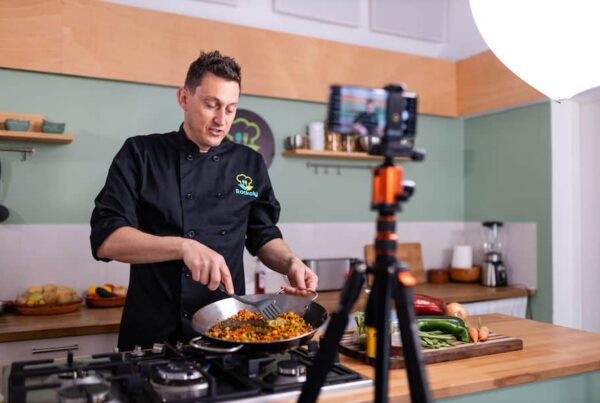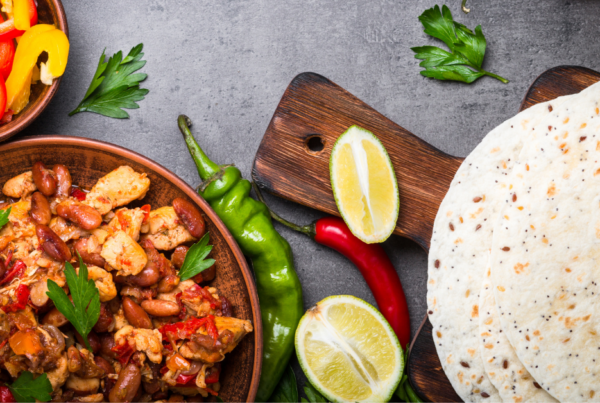It’s not easy to put Asian food into a single box. The Asian continent is massive, with a landmass covering more than 14 million square miles. Asia is home to almost five billion people (more than 60% of the world’s population) and expands into three hemispheres.
It’s no wonder that so many gastronomical wonders come from this diverse continent and that Asian food is well-loved throughout the world.
Despite the diversity, Asian food is still broadly placed into three categories – with plenty of room to move and spill into each other.
Southwestern
The southwestern style of cuisine has its roots in the ancient Persian civilizations. It includes the foods that we have come to associate with India, Pakistan, and parts of the Middle East.
Flatbreads, curries and strong spices dominate the menu, and the Hindu influence has made way for many vegetarian dishes. Mutton features strongly, and you won’t find many recipes that include beef. This is because Hinduism reveres cows as sacred, and they are used only for milk – never meat.
Northeastern

Northeastern Asian food is usually what first springs to mind when we think of food from the continent.
It is the style that spread to the western world many years ago, as immigrants brought their traditional recipes to their new home. Many used their knowledge of the cuisines to start restaurants that are now firmly entrenched in western food culture.
Northeastern food is primarily from China, Korea and Japan. The cooking styles vary between the regions, but strong spices, garlic, noodles, and deep frying are used across the board.
Southeastern
Southeast Asian food has grown in popularity across the globe. Food from Malaysia, Thailand, Singapore, Cambodia and Vietnam fall into this category. The food is synonymous with fresh vegetables, stir-frying, steaming, and plenty of subtle seasonings like lemongrass, cilantro, and citrus.
Curries are also a popular dish but differ from southwestern curries. Southeastern curries use coconut milk as a base, whereas the southwest favours yoghurt.
Southeastern and Northeastern Asian cuisine uses a lot of noodles, but Southwestern food favours flatbreads.
Rice, garlic and ginger feature heavily in all three regions.
Rockoly’s Asian Delights

While it would be a challenging and costly exercise to travel the Asian continent and sample all the different cooking styles, we are fortunate to live in a world where technology can bring Asia to us.
And what better way to do this than infusing your company team-building events with an abundant variety of Asian food.
Rockoly can take your team on a virtual food tour, where they can indulge in the unmistakable flavours of Asia through a series of virtual team-building workshops.
Japan
You cannot think of Japanese cuisine without thinking about sushi. Interestingly, sushi originated in China between the 5th and 3rd centuries BC. Chinese travelers introduced the dish to Japan six hundred years later, and they embraced it, making it their own.
The raw fish version that we have come to know only came about many years later. The fish was originally salted and fermented to preserve it. The rice was also used to protect the fish and was often thrown out.
When many Japanese people immigrated to the US after the Meiji restoration, they brought the art of sushi making with them, but it was an exclusive dish enjoyed by the upper class. However, it had a boost in popularity after the 2nd World War and eventually became a much-loved favorite among Americans during the 60s.
Master the art of sushi making with one of Rockoly’s specialized Asian food workshops. Together, you and your team will learn how to prepare the perfect Sushi rice and create delicate California Maki Rolls with fresh cucumber, avocado and crab or surimi. But, of course, sushi is not sushi unless it is served with salty soy sauce and fiery wasabi.
Rockoly’s online team-building workshops will not only teach how to make authentic Asian food – they will immerse you in the culture. Enjoy Japan’s unique alcoholic beverage, sake, and take a course on traditional sake etiquette.
For example, did you know it is rude to pour your own sake? You always pour for someone else, and they will return the favor. Always hold your sake in two hands and only start sipping when everyone has a full cup, and the host has raised his glass. Kanpai! (Cheers!)
Of course, there is far more to Japanese cuisine than sushi. Their delicious specialities are considered some of the healthiest in the world, but they are by no means boring. Some of their lesser-known dishes include:
Buta-No-Shogayaki (Ginger Pork) – Thin slices of roast pork, delicately dressed in a sauce made from sake, ginger and soy sauce.
Champon – Delicious ramen noodles boiled in a seafood, pork or vegetable broth. The ingredients are fried in lard beforehand, making the broth extremely satisfying.
Edamame – Edamame beans are usually served as a snack. Unripened soybeans are grilled in their pods and seasoned with salt. Simple yet delicious.
Fugu – Fugu is not for the faint-hearted. It is the meat of a highly toxic pufferfish, and if it is not prepared correctly, it can be deadly. Don’t worry, though. Chefs spend years training to get the technique right, and since the serving of fugu was regulated, there have been no fatalities related to licenced restaurants.
Gyoza – These moon-shaped dumplings originated in China but are now an iconic Japanese delight. The dumplings are stuffed with minced pork, garlic, ginger and cabbage before being lightly fried and served hot.
China
Chinese cuisine goes back further than 1000BC and is one of the oldest cuisines in the world. Chinese civilization stabilized and began growing long before most, which is why their cuisine took root early on, evolving rapidly. China is a vast country and has seven climate zones, so there is a constant supply of various ingredients.
Noodles, rice, spices, sauces, veggies and meat punctuate their menus, and each region has their specialities and variations.
Some of the most well-loved Chinese dishes include:
Chow mein –Stir-fried noodles and fresh veggies are mixed in a wok with spices and soy sauce. Meat or tofu are often added to add variety and texture
Sweet and sour dishes – These have been enjoyed in China for centuries. There are records of it being served as far back as 700CE during one of the festivals. Some historians believe that the original sweet and sour sauce comes from the province of Henan. Vinegar would be boiled with sugar to create a dipping sauce for fish.
Fried Rice – Rice paddies thrive in China, so it stands to reason that it is a staple food that features in many dishes. But just because it’s a staple doesn’t mean it can’t be experimented with and taken to new heights. Cooked rice is pan-fried in a wok, and a beaten egg is added to the mix. They mold together to create a magnificent combination synonymous with Asian food.
India
India is a lot more diverse than people realize. It has 22 official languages and more than 100 additional languages. While Hinduism dominates the nation, Sikhism, Christianity, Islam and Buddhism are widely practised. Throw in some historical events such as invasions, trade routes and colonialism, and one can understand that this melting pot results in a variety of cultural cuisines.
Curry is the most recognized Indian meal but is a broad term. There are well over 150 curry variations. The name curry comes from the Tamil word “Kari”. It means a soup or sauce to be eaten with rice. Common ingredients include coriander, garlic, star anise, turmeric, cumin, and chillies.
Rockoly will expand on your Asian food team-building experience with their mouth-watering Tikka Masala. This traditional dish is created with marinated chicken roasted in spiced curry sauce. It is recognizable by its deep orange collar and creamy texture. Spice up your team building event and create your tikka chicken with a side of Basmati rice. Chickpeas make an excellent substitute for a vegan alternative. Expand your skills and create fresh naan from scratch – a favorite everyone will love.
Another Indian favorite is Korma. While the exact style varies from region to region, the traditional North Indian version is the one we are most familiar with. It is usually made with lamb or chicken, which is braised and smothered in a fragrant, slightly sweet gravy consisting of yoghurt, cashew nuts, ginger and garlic. This moreish concoction is an excellent option for those sensitive to overly spicy food and is extremely popular in the United Kingdom, where Indian food is prevalent.
Nepal
Nepal is a somewhat mysterious land. Nestled in the Himalayan mountains, it is home to eight of the ten highest mountains in the world – Everest included.
Nepalese cuisine is varied due to the diverse climate and topography of the land – the lowlands can reach temperatures of up to 105° F in the summer months, yet the highlands have an Arctic climate that is extremely cold during winter.
It is, nonetheless, still unmistakably Asian food. Dal is a typical meal throughout the land – a hearty lentil soup, spiced up and served over rice – and there is a heavy Indian influence on their staple foods. Samosas – triangular pastries stuffed with a meat or vegetable filling are deep fried and served hot. Spicy preserves such as chutney and achaar are popular condiments, and buffalo milk is often used as it is easier to farm buffalo in the region than cows.
Rockoly will host your team building cooking workshop and guide your team to create their own mouth-watering Momo. These traditional South Asian dumplings are little bursts of flavor. Learn how to create dough from scratch and add juicy chicken, fragrant ginger, pungent garlic, and various spices to create the perfect savory dumpling. Serve with a delectable dipping sauce and enjoy the flavor explosion.
Thailand
The former land of Siam is a popular travel destination known for its crystal-clear water and breathtaking beaches. However, in 2004, much of the coastal region was destroyed by the Indian Ocean Tsunami that took more than 220 000 lives.
The Thai people rely heavily on tourism and showed their incredible resilience by rebuilding their homes in record time, although scars are still visible and serve as a memorial to those who lost their lives, homes and livelihood
The region is primarily Buddhist, and its cuisine is rooted in Chinese traditions but lighter, more fragrant and punctuated with its own flare. Thailand is also known for their unique curries that differ from the heavy Indian varieties – favouring coconut milk and lemongrass over yogurt and masala.
Thai cuisine is roughly divided into four categories: yam (spicy salads), tom (boiled dishes), tam (pounded foods), and gaeng (curries).
In 2017, CNN travel conducted an online poll – completed by 35 000 participants. As a result, seven Thai dishes were recognized on the “World’s 50 Best Foods” list – more than any other country.
Rockoly online team-building workshops offer two delicious Thai dishes as a part of their Asian food menus.
Thai Summer Rolls
Light, healthy and uniquely Thai, these fresh spring rolls are wrapped in rice paper and filled with crunchy vegetables, delicious shrimp, and tasty noodles. Create these delightful snacks with your team and pair them with a homemade dipping sauce. You won’t be able to stop eating these handheld rolls.
Pad Thai
Pad Thai is a typical street food dish of stir-fried noodles in a savory sauce. Prepare this Asian food wonder with your team using shrimp, tofu, and vegetables – you will want to make it over and over again.
The Middle East
The Middle East – or West Asia – is the region often referred to as The Fertile Crescent and was the cradle of early civilizations such as Mesopotamia, Samaria and Babylonia. West Asian food incorporates Arab, Armenian, Lebanese, Turkish and Israeli food, to name a few.
A Middle Eastern menu includes a lot of olives, olive oil, dates, chickpeas, honey and yoghurt. The northern parts of Africa – especially Egypt and Morocco – are heavily influenced by the Middle Eastern diet and have contributed over the centuries.
Islam and Judaism are prominent religions in the area and have also influenced the cuisine. Neither eats pork, so you won’t find it featured on a local menu. The Ottoman Empire also played a role in defining west Asian food – bringing a love of thick coffee and sweet pastries made with thin phyllo dough.
While meze is often considered a Mediterranean dish, its roots lie in the Middle East. Like Spanish tapas, it comprises a platter of foods ideal for sharing, such as cheese, nuts, dips such as tabbouleh and hummus. Grilled meat, and kibbeh are also included. Flatbreads are served as an accompaniment.
Most traditional west Asian food is eaten by hand, using flatbread to scoop up dips and sauces.
Shakshuka
Shakshuka is thought to have originated in Yemen, but many believe it came from the Ottoman Empire. The dish is now a popular Israeli delicacy, but its version is derived from North African influences.
North African immigrants created this affordable dish, made with eggs, vegetables and bread, to help get the most nutrition out of a small meal. It is now a typical favorite and has been adapted to include a variety of spices, herbs, cheeses and meat.
Rockoly has a variety of West Asian food on their team-building workshop menus, including a hearty shakshuka. Perfectly poached eggs are smothered in a spicy tomato sauce and served with warm, fluffy homemade pita bread. The perfect brunch dish is best served with a feisty bloody Mary or a steaming cup of Turkish coffee.
Tahini and Hummus
One of the Middle East’s most well-loved exports, tahini is a thick paste made of sesame seeds and a base for many other dips and sauces. It is also enjoyed on its own, as a spread or dip on a fresh flatbread. However, hummus takes tahini to the next level.
Mashed chickpeas are added to the tahini base and infused with lemon juice, olive oil and fresh garlic. Hummus is loved worldwide and used as a dip for crudité, potato chips and pita bread – but it is delicious enough to have with almost everything savory.
Russia
Russia is often forgotten when people think of Asian food. But it is not only the largest country in Asia, it is also the largest in the world. Russia has a foot on both continents, but most of its landmass is Asian. In fact, it far Eastern coast is only 55miles from the US coastline. However, most of its population lives in its European region.
Russia’s diverse landscape has significantly influenced its cuisine, but early Russian dishes date back to the 10th century. Its vast forests, lakes and rivers supplied an abundance of game, fish, mushrooms and berries. In addition, various grains are grown throughout the region – rye, oats, wheat, barley, and buckwheat. As a result, Russians eat porridge made from various grains throughout their lives and it is considered a national dish.
Каша – матушка наша, а хлебец ржаной – отец наш родной
Porridge is our mother, bread is our father
Russians are avid tea drinkers and have been since the 17th century, but their most famous beverage is vodka. The first Tsar Bar was opened as far back as the 16th century when Ivan the Terrible endorsed it, and its popularity spread. Vodka translates to ‘little water’, and it is now the most popular distilled alcoholic drink worldwide.
The Russian stove made their food truly unique it was used for baking bread, brewing beer and drying food – all while warming Russian homes during the frigid winters – but they are no longer used today.
When St. Petersburg served as the capital, the proximity to Western Europe influenced their cuisine significantly.
However, some dishes are Russian through and through.
Okroshka is a traditional cold soup made with vegetables and meat. There are two varieties – a neutral-tasting broth of potatoes, turnips, rutabagas, and carrots and a spicy and aromatic version containing radishes or green onion and other herbs.
Borscht is possibly the most famous Russian export – a bone broth made with beets, onions, cabbage, and celery. Like most national dishes, it began its life as a peasant food that was cheap to make and concocted from offcuts and leftovers. Borscht is served piping hot and flavoured with delicious a sour cream, chive and garlic mix. Black bread is served on the side.
Beef Stroganoff is a quintessential Russian dish – although a French chef created it. The story goes that Count Pavel Alexandrovich employed a private chef named Charles Briere, who created the dish as a part of a cooking contest.
However, historians have disproved the former part of the story. Stroganoff contains strips of beef tenderloin, sautéed and blended with sour cream and was a dish reserved for the aristocracy until it made its way across the globe.
Enjoy Asian Food with Rockoly
Asian food is diverse, delicious and hugely popular throughout the world. Rockoly will bring the joy of Asian food to your door with an Asian food team-building extravaganza.
A professional chef will guide you through your cooking experience with video conferencing, helping everyone create exciting meals together. In addition, Rockoly’s Asian food workshops encourage connection, boost morale, and foster socialization.








